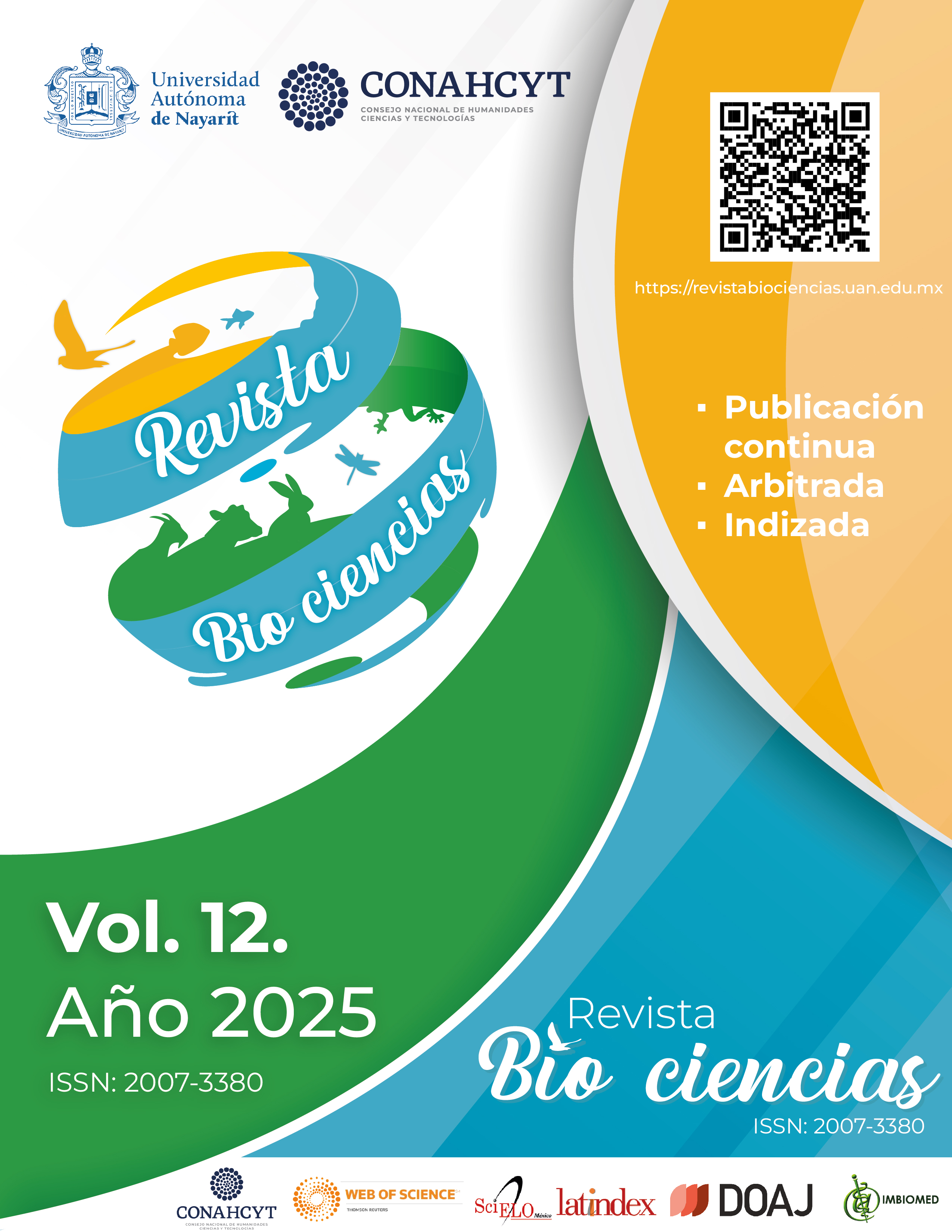Abstract
Persian lime (Citrus x latifolia Tan.) is a key crop in Veracruz, with production affected by fungal diseases. To reduce the use of chemical fungicides, the use of Biological Control Agents (BCAs), such as bacteria from the Bacillus genus, has been investigated. In this study, the in vitro antagonistic effect of Bacillus velezensis (Bv) and two strains of Bacillus subtilis (Bs1 and Bs2) was evaluated against the pathogens responsible for dieback (Lasiodiplodia spp.) and anthracnose (Colletotrichum sp.), isolated from Persian lime orchards in Tierra Blanca, Veracruz. The Percentage of Radial Growth Inhibition (PRGI) was measured on potato dextrose agar plates.
Bacillus subtilis strains showed inhibition of the evaluated pathogens. Bs2 presented the highest inhibition percentages (66.69% and 61.78%) against Lasiodiplodia spp. (Las1 and Las2). Bs1 showed 49.7% inhibition against Colletotrichum sp. (Colle). In contrast, Bacillus velezensis (Bv) exhibited a low antagonistic effect, with only 8.4% inhibition against Las1 and no inhibition against the other strains. These results indicate that Bacillus subtilis Bs1 and Bs2 strains have high potential as BCAs against pathogens affecting Persian lime production.
References
Balthazar, C., Novinscak, A., Cantin, G., Joly, D. L., & Filion, M. (2022). Biocontrol Activity of Bacillus spp. And Pseudomonas spp. Against Botrytis cinerea and Other Cannabis Fungal Pathogens. Phytopathology, 112(3), 549-560. https://doi.org/10.1094/PHYTO-03-21-0128-R
Bautista-Cruz, M. A., Almaguer-Vargas, G., Leyva-Mir, S. G., Colinas-León, M. T., Correia, K. C., Camacho-Tapia, M., Robles-Yerena, L., Michereff, S. J., & Tovar-Pedraza, J. M. (2019). Phylogeny, distribution, and pathogenicity of Lasiodiplodia species associated with cankers and dieback symptoms of persian lime in Mexico. Plant Disease, 103(6), 1156-1165. https://doi.org/10.1094/PDIS-06-18-1036-RE
Berg, G., & Smalla, K. (2009). Plant species and soil type cooperatively shape the structure and function of microbial communities in the rhizosphere. FEMS Microbiology Ecology, 68(1), 1-13. https://doi.org/10.1111/j.1574-6941.2009.00654.x
Cambero-Ayón, C. B., Luna Esquivel, G., Rios Velasco, C., Estrada Virgen, O., Betancourt Aranguré, A., & Cambero Campos, O. J. (2020). Evaluación in vitro de antagonistas contra patógenos de fruto de guanábana (Annona muricata L.) en Nayarit, México. Revista Brasileira de Fruticultura, 42(2). https://doi.org/10.1590/0100-29452020147
Castañeda-Alvarez, E., & Sánchez, L. C. (2016). Evaluación del crecimiento de cuatro especies del género Bacillus sp., primer paso para entender su efecto biocontrolador sobre Fusarium sp. Revista Nova Publicación Científica en Ciencias Biomédicas, 14(26), Article 26. https://doi.org/10.22490/24629448.1751
Castillo-Reyes, F., Hernández-Castillo, F. D., Gallegos-Morales, G., Flores-Olivas, A., & Rodríguez-Herrera, R. (2015). Efectividad in vitro de Bacillus y polifenoles de plantas nativas de México sobre Rhizoctonia solani. Revista Mexicana de Ciencias Agrícolas, 6(3), Article 3. https://doi.org/10.29312/remexca.v6i3.638
Chavarria-Quicaño, E., Contreras-Jácquez, V., Carrillo-Fasio, A., De la Torre-González, F., & Asaff-Torres, A. (2023). Native Bacillus paralicheniformis isolate as a potential agent for phytopathogenic nematodes control. Frontiers in Microbiology, 14. https://doi.org/10.3389/fmicb.2023.1213306
Chen, K., Tian, Z., He, H., Long, C., & Jiang, F. (2020). Bacillus species as potential biocontrol agents against citrus diseases. Biological Control, 151, 104419. https://doi.org/10.1016/j.biocontrol.2020.104419
Chukeatirote, E., Niraphai, K., Sardsud, U., & Popluechai, S. (2018). Identification of antagonistic bacteria isolated from Thai fermented soybean (Thua Nao) for biocontrol of Lasiodiplodia theobromae. https://doi.org/10.1556/038.53.2018.004
Espinoza-Ahumada, C. A., Gallegos Morales, G., Hernández Castillo, F. D., Ochoa Fuentes, Y. M., Cepeda Siller, M., & Castillo Reyes, F. (2019). Antagonistas microbianos a Fusarium spp., como agente causal de pudrición de raíces y tallo en melón. Ecosistemas y Recursos Agropecuarios, 6(16), Article 16. https://doi.org/10.19136/era.a6n16.1843
Ezziyyani, M., Sánchez, C. P., Requena, M. E., Rubio, L., & Castillo, M. E. C. (2004). Biocontrol por Streptomyces rochei –Ziyani–, de la podredumbre del pimiento (Capsicum annuum L.) causada por Phytophthora capsici. Anales de Biología, 26, 61-68. https://revistas.um.es/analesbio/article/view/30471
Gálves-Gamboa, G. T., Sánchez Servín, M. R., Parra Cota, F., García Pereyra, J., Aviña Martínez, G. N., & Santos Villalobos, S. (2018). Plaguicidas en la agricultura mexicana y potenciales alternativas sustentables para su sustitución. Revista Biológico Agropecuaria Tuxpan, 6(1), 61-75. https://doi.org/10.47808/revistabioagro.v6i1.138
Kakraliya, S. S., Choskit, D., Pandit, D., & Abrol, S. (2017). Effect of Bio-Agents, Neem Leaf Extract and Fungicides Against Alternaria Leaf Blight of Wheat (Triticum aestivum L.). Natural Products Chemistry & Research, 05(08). https://doi.org/10.4172/2329-6836.1000295
Khuong, N. Q., Nhien, D. B., Thu, L. T. M., Trong, N. D., Hiep, P. C., Thuan, V. M., Quang, L. T., Thuc, L. V., & Xuan, D. T. (2023). Using Trichoderma asperellum to Antagonize Lasiodiplodia theobromae Causing Stem-End Rot Disease on Pomelo (Citrus maxima). Journal of Fungi, 9(10), 981. https://doi.org/10.3390/jof9100981
Leyva-Mirs, S. G., Bautista-Cruz, M. A., Almaguer-Vargas, G., Colinas-Leon, M. T., Tovar-Pedraza, J. M., & Camacho-Tapia, M. (2021). Efectividad de fungicidas y Trichorderma spp. Para el control de Lasiodiplodia spp. En huertos de limón ‘Persa’ en Veracruz. Revista Mecana de Ciencias Agrícolas, 12(2), 345-353. https://doi.org/10.29312/remexca.v12i2.2551
Martínez-Martínez, T. O., Martínez-Camacho, A. P., Rodríguez-Guerra, R., Mariscal-Amaro, L. A., Rivas-Valencia, P., Martínez-Martínez, T. O., Martínez-Camacho, A. P., Rodríguez-Guerra, R., Mariscal-Amaro, L. A., & Rivas-Valencia, P. (2023). Isolation and identification of antagonistic fungi of fungi associated with chili wilt in southern Guanajuato, Mexico. Revista Mexicana de Fitopatología, 41(2), 268-284. https://doi.org/10.18781/r.mex.fit.2302-1
Moreno-Velandia, C. A., Ongena, M., & Cotes, A. M. (2021). Effects of Fengycins and Iturins on Fusarium oxysporum f. Sp. Physali and Root Colonization by Bacillus velezensis Bs006 Protect Golden Berry Against Vascular Wilt. Phytopathology®, 111(12), 2227-2237. https://doi.org/10.1094/PHYTO-01-21-0001-R
Ordóñez-Beltrán, V., Orduño-Cruz, N., Ríos-Velasco, C., Jacobo-Cuellar, J. L., Hernández-Domínguez, C., & Acosta-Muñiz, C. H. (2020). Characterization of Rhizobacteria Associated with Vitis vinifera and Its Interaction in vitro with Entomopathogenic Fungi. Eurasian Soil Science, 53(10), 1469-1479. https://doi.org/10.1134/S1064229320100130
Rabbee, M. F., Ali, Md. S., Choi, J., Hwang, B. S., Jeong, S. C., & Baek, K. (2019). Bacillus velezensis: A Valuable Member of Bioactive Molecules within Plant Microbiomes. Molecules, 24(6), 1046. https://doi.org/10.3390/molecules24061046
Ruiz, A., Parra, C. C., da Graҫa, J. V., Salas, B., & Kunta, M. (2014). Caracterización Molecular y de Ensayos de Patogenicidad de Colletotrichum acutatum, Agente Causal de la Antracnosis del Limón en Texas. Revista Mexicana de Fitopatología, 32(1), 52-61. https://rmf.smf.org.mx/Contenido_Vol_32_1_2014.html
Sáenz-Pérez, C. A., Osorio Hernández, E., Estrada Drouaillet, B., Poot Poot, W. A. P., Delgado Martínez, R., & Rodríguez Herrera, R. (2019). Principales enfermedades en cítricos. Revista Mexicana de Ciencias Agrícolas, 10(7), 1653-1665. https://doi.org/10.29312/remexca.v10i7.1827
Sajitha, K. L., & Dev, S. A. (2016). Quantification of antifungal lipopeptide gene expression levels in Bacillus subtilis B1 during antagonism against sapstain fungus on rubberwood. Biological Control, 96, 78-85. https://doi.org/10.1016/j.biocontrol.2016.02.007
Sajitha, K. L., Maria Florence, E. J., & Dev, S. A. (2014). Screening of bacterial biocontrols against sapstain fungus (Lasiodiplodia theobromae Pat.) of rubberwood (Hevea brasiliensis Muell.Arg.). Research in Microbiology, 165(7), 541-548.
SIAP. (2023). Anuario Estadístico de la Producción Agrícola. Servicio de Información Agroalimentaria y Pesquera. https://nube.siap.gob.mx/cierreagricola/
Valenzuela Ruiz, V., Gálvez Gamboa, G. T., Villa Rodríguez, E. D., Parra Cota, F. I., Santoyo, G., & de los Santos Villalobos, S. (2020). Lipopéptidos producidos por agentes de control biológico del género Bacillus: Revisión de herramientas analíticas utilizadas para su estudio. Revista Mexicana de Ciencias Agrícolas, 11(2), Article 2. https://doi.org/10.29312/remexca.v11i2.2191
Vinchira-Villarraga, D. M., & Moreno-Sarmiento, N. (2019). Control biológico: Camino a la agricultura moderna. Revista Colombiana de Biotecnología, 21(1), 2-5. https://doi.org/10.15446/rev.colomb.biote.v21n1.80860
Wei, J., Zhao, J., Suo, M., Wu, H., Zhao, M., & Yang, H. (2023). Biocontrol mechanisms of Bacillus velezensis against Fusarium oxysporum from Panax ginseng. Biological Control, 182, 105222. https://doi.org/10.1016/j.biocontrol.2023.105222
Yan, H., Qiu, Y., Yang, S., Wang, Y., Wang, K., Jiang, L., & Wang, H. (2021). Antagonistic Activity of Bacillus velezensis SDTB038 against Phytophthora infestans in Potato. Plant Disease, 105(6), 1738-1747. https://doi.org/10.1094/PDIS-08-20-1666-RE
Zhang, R., Wang, F., Qi, Z., Qiao, J., Du, Y., Yu, J., Yu, M., Liang, D., Song, T., Pan, X., Cao, H., Zhang, H., & Liu, Y. (2022). Iturins Produced by Bacillus velezensis Jt84 Play a Key Role in the Biocontrol of Rice Blast Disease (SSRN Scholarly Paper 4089141). Social Science Research Network. https://doi.org/10.2139/ssrn.4089141

Revista Bio Ciencias by Universidad Autónoma de Nayarit under Creative Commons Attribution-NonCommercial 3.0 Unported License.
Based on work of http://biociencias.uan.edu.mx/.
Further permits not covered by this licence can be found at http://editorial.uan.edu.mx/index.php/BIOCIENCIAS.






